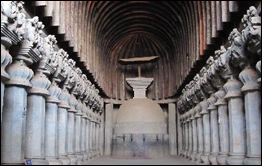|
BUDDHIST DESTINATION |
|
|
|
|
|
|
|
|
|
|
|
|
|
|
|
|
|
BUDDHIST SITES |
|
|
|
|
|
|
|
|
| KARLA CAVES |
|
|
Karla caves are at a distance of 11 kms. from Lonavala just off the Mumbai � Pune highway. The magnificent chaitya hall at Karla is the largest (124 ft. X 46.5 ft. X 45 ft.) and most evolved example of its class. The most important features of the interior of hall are columns or pillars, the roof vault and the great windows. There are 37 columns in all, of which 30 have interesting capitals showing prosperous men and women riding elephant and horse yet bowing in humility to the great Lord Buddha depicted in the form of hemispherical stupa. The vaulted roof has wooden supports. This is the only Buddhist site in India, where 2000 year old wood blocks can be seen. At the far end of the hall stands a stupa, the top of which is crowned with an umbrella, a symbolic representation of Lord Buddha.
The high hill called Valizuka in ancient days, contains a dozen rock cut monasteries,a few rock � cut cisterns and a chaitya � grihya at a height of about 360 ft. that can be datedfrom 1st century AD to 7th century AD. The chaitya griha, with its developed architectural features displaying a pleasing harmony of form and properties and of breathtaking beauty, markes the culmination of the early phase of Buddhist architecture. |
 |
| Karla caves Attractions |
The caves are beautifully decorated with many animals and different forms of human life, artistically expressed through the sculptures cut out of rock. The Chatya hall is worth a detailed watch for its architecture and engineering skills. The rooftop is built of Teakwood and amazingly, its still in perfect condition. The pillars are also sculptured, and the one with four lions at the top has been honoured as the national emblem. The expressions of all these sculptures are splendid, and they successfully represent a flourishing era of Buddhism.
There is a stone stupa, magnificent in view, which makes the caves more important both in architectural and tourist point of view. The stupa is placed under an umbrella, to give it a royal look. There are delicate carvings of structures of men, women and elephants, resembling to some of the old Buddhist tales. There are 37 pillars with carvings of affluent men and women, on elephants, yet bowing to the almighty Lord Buddha.
Another intrinsic beauty of these caves is its "hide n seek" with the sunshine. The sunshine coming in through the windows and falls exactly on the shrine, making it a miraculous view and a temple of solemnity.
The roof has been beautifully wood-worked to make the caves a rare example of beauty. Surprisingly, woodwork is not a common feature in Buddhist sculpture and art, and hence it shows effect of other cultures that assimilated with the Buddhist art, to give it a refreshingly new look.
The pillars are also linked to the Ashoka who, had built many structures to spread Buddhism, and are great examples of architecture and art. |
| How to Reach |
Air - Pune airport, in Lohegaon, at a distance of 55 km is the nearest and a major airport of Maharashtra.
Rail - There is a local railway station at a distance of 5 km, Malavil, in Bhaja Village, however, Pune is a better known and well connected railway station.
Road - The caves are reachable through the Mumbai Pune road. Buses between Mumbai and Pune go via Karla and hence easily reachable. However, private rented vehicles are also available.
|
|